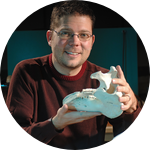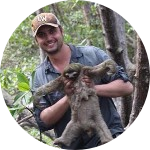About This Project
It’s well established: tree sloths are weird. So we can assume that extinct ground sloths were weird too. Studying sloths is tough because it’s hard/impossible to observe their behaviors, yet knowing their (paleo)ecology is important for conservation and interpreting paleoecosystems. Our project will use stable isotopes as a proxy for diet/habitat thus eschewing direct observation. This serves two goals: a better grasp of sloth ecology and a metric for applying these techniques to fossil sloths.
Ask the Scientists
Join The DiscussionWhat is the context of this research?
I was inspired to do this project because the more I learn about sloths the more I realize just how little we know about them. The work I did for my Masters looked at the microscopic surface texture of modern and fossil sloth teeth to tell what they were eating, and for my Ph.D. I wanted to take those sorts of proxies to the next level. Stable isotope analysis is a really great tool for that. The technique relies on the old adage, “you are what you eat” but in this case we’re talking about the actual atoms in your food and water that turn into the tissues of your body. By analyzing those tissues, we can get a sense of what you were eating and drinking when those tissues were forming, which is super helpful when you can’t observe the animal because they’re extinct or up a really high tree.
What is the significance of this project?
The reason I really wanted to develop this project is simple: it’s work that needs to be done but hasn’t yet. As a paleontologist, I was aware of a handful of studies that looked at the stable isotope geochemistry of fossil sloths. These results were typically interpreted as any other large herbivore (remember: ground sloths were huge) even though the tissue being sampled was different and sloths weren’t closely related to the herbivores they were being compared to. I see this as a problem. Sloths are weird. Weird enough that I was skeptical of any untested assumptions about their ecology, so that’s why I’m proposing this project, which will test modern sloths to learn a lot we don’t know about their ecology and see if they’re better a comparison for interpreting their fossil relatives.
What are the goals of the project?
There are two main goals for this project. The first is to use stable isotope analysis to greatly increase our knowledge of modern sloth ecology. The second is to use those insights to rethink how we view similar data from fossil sloths. These results will form a chapter of my Ph.D. dissertation and will also be presented at conferences, published in peer-reviewed journals, and talked about on my podcast. Last year I collected the samples I’d need from deceased frozen sloths at the Sloth Sanctuary in Costa Rica, but I left the samples there while I waited for the proper permits to export them to the US, which we got a few months ago. With funding, I’ll head down to pick them up. Once back, I’ll get the samples prepared and analyzed over the summer with plans to begin writing in the fall.
Budget
The samples I need to analyze are currently waiting to be picked up at the Sloth Sanctuary in Costa Rica. Most international shippers don't want to mail bits of sloth, so I need to go get them myself and bring them back to the University of Wyoming. Then I'll prepare the samples in our paleobiology lab within the Department of Geology and Geophysics, which will take a few weeks. Once prepared, I’ll walk the samples next door to the Stable Isotope Facility. One mass spectrometer will be used to measure the stable carbon and stable nitrogen values of the samples, and a duplicate set of samples will have their stable oxygen and stable carbon values analyzed by a different mass spectrometer. The carbon/nitrogen analysis costs $6.50 per sample and the stretch goal of oxygen/carbon analysis costs $8.50 per sample. I’m planning on running a LOT of samples (>300) to generate a really robust dataset that will allow me to do some serious statistics and yield the strongest results possible.
Endorsed by
Meet the Team
Team Bio
Becky and I like to describe ourselves as the "Sloth Science Supersquad of Justice and Friendship", which feels like a pretty accurrate description of our work and relationship. The sorts of things we research about sloths are different but complementary. And with the help of our awesome advisors, Rory Wilson and Mark Clementz, respectively, we've been able to collaborate on some truly ambitious projects that are pushing the boundaries of everything we know about the weirdos that are sloths.
Ryan J. Haupt
People often ask me when I became fascinated with sloths. The honest answer is that one day I was meeting with my Masters advisor and we were brainstorming projects. She mentioned what I thought was a really cool question about armadillo and sloth teeth (neither have enamel, just dentin that keeps growing). With that, I was off to the races, designed a project to test how well the microscopic texture of their teeth records the food they eat, finished up my Masters and realized I still had a lot more questions about these really weird animals. So I started a Ph.D. at the University of Wyoming and have continued to develop research projects to try and figure out just what exactly is going on with these weirdos. I really like my job. In my off hours, I produce and host my popular podcast, Science... sort of, which I'm immensely proud out.
Becky Naomi Cliffe
Becky Cliffe is a British zoologist who has worked for years at the Sloth Sanctuary of Costa Rica and is currently in the process of completing her Ph.D. from Swansea University. She has published a number of papers about sloth biology, with more on the way, and has appeared in several documentaries highlighting these wonderful weirdos. She has a dog named Cody which she thinks is the cutest but Ryan thinks he's a bit too fluffy and slobbery for the tropics and is ultimately incapable of climbing tress to help us get to the sloths. You be the judge! You can learn more about Becky on her website: beckycliffe.com
Project Backers
- 115Backers
- 165%Funded
- $6,116Total Donations
- $44.49Average Donation



